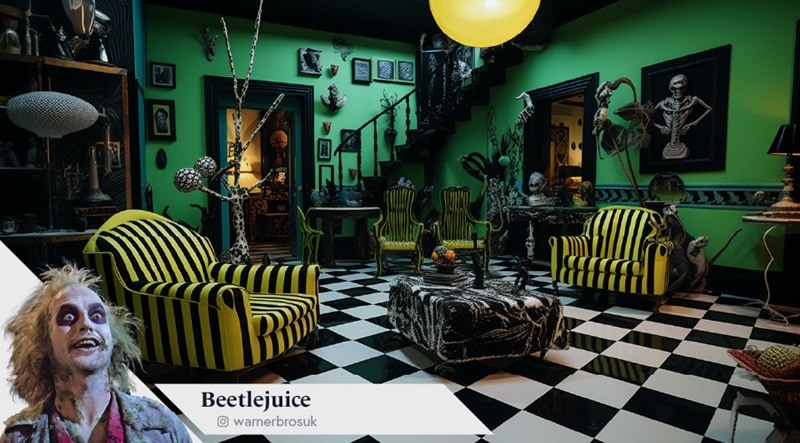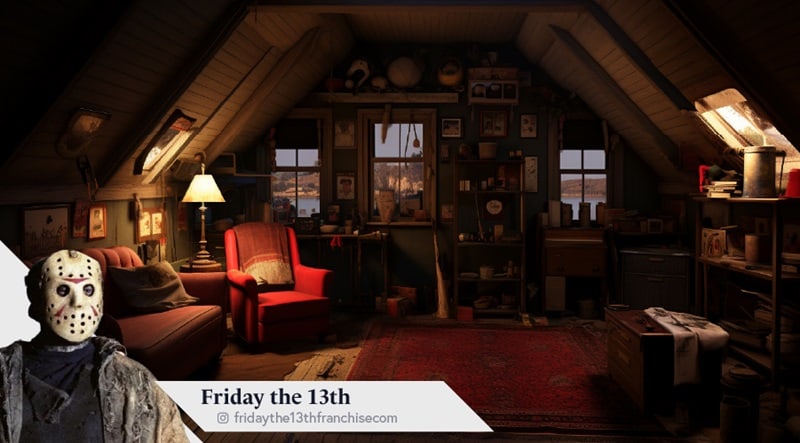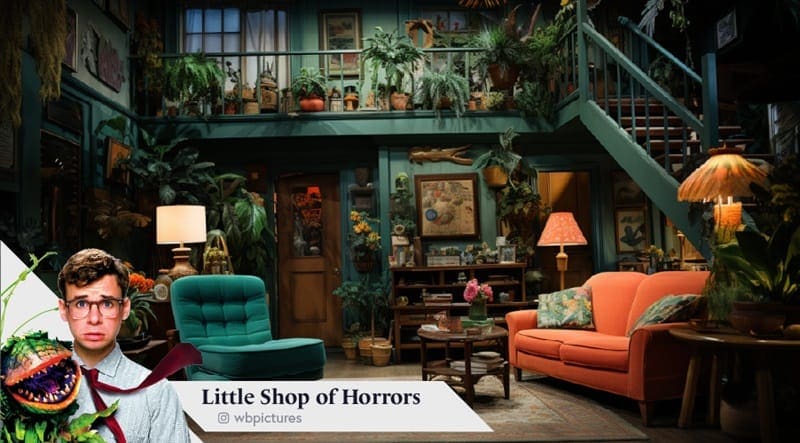As the autumn leaves fall and the air grows chill, the timeless allure of classic Halloween movies beckons us once again to the eerie and fantastical realms they depict.
Films like Beetlejuice, Hocus Pocus, The Addams Family, Sleepy Hollow, The Nightmare Before Christmas, and Friday the 13th have become staples of the season, drawing us into worlds where the supernatural reigns and the eerie takes center stage.
Yet, beyond the talented actors, eerie plotlines, and haunting soundtracks, there is another essential element that breathes life into these cinematic masterpieces — the sets and interiors.
These iconic films transport us to a realm where witches, ghosts, monsters, and vampires coexist with the living, where the macabre meets the mundane. The interiors of these movies play a pivotal role in setting the stage, creating an ambiance that is both captivating and spine-tingling.
They are the canvas on which the artists behind the scenes — visionary movie directors, stellar production designers, and art directors — paint a rich tapestry of emotions, invoking a unique blend of awe and fear that leaves a lasting imprint on our psyche.
It’s no secret that the setting and backdrop for a movie are of paramount importance, but in the realm of fantasy and horror, this importance is magnified. A well-crafted set can serve as a character in its own right, immersing the audience in a carefully designed world where the surreal becomes reality.
The creaking floorboards, dimly lit corridors, and eerie artifacts scattered about these cinematic interiors hold the power to transport us to the very heart of the narrative, intensifying our connection to the story and its characters.
Reimagining the interiors of our favorite Halloween classics with the help of AI

These classic Halloween movies, some dating back decades, have become an annual tradition for many, a comforting yet spine-tingling journey back to a time when our greatest fear was the monster under our bed.
They’ve left an indelible mark on our hearts and imaginations, making us yearn for the feeling of nostalgia and suspense they offer. In a world that perpetually seeks the new and novel, there is a unique satisfaction in revisiting these timeless classics, like worn pages in a cherished book.
But, what if you could revisit these iconic movie interiors in a fresh, modern light? What if you could reimagine the Addams Family mansion in the 21st century or walk through the halls of Sleepy Hollow with a new perspective? Thanks to the wonders of artificial intelligence and computer-generated imagery, we can now explore these treasured movie settings as if they were born anew.
With a little help from the creative team over at Swift Direct Blinds, we’ll delve into the magic of AI-generated images that recreate the interiors of our favorite Halloween movies. These images provide a modern lens through which we can appreciate the artistry of the original sets while also marveling at the potential for reinterpretation.
By fusing the nostalgia of yesteryears with the technological prowess of today, we bridge the gap between tradition and innovation, offering a fresh look at the beloved and the eerie. Join us as we embark on a journey to unearth the haunted beauty of classic Halloween movie interiors, rekindling our love for the timeless and the macabre in a new, hauntingly realistic light.
#1 Beetlejuice
Beetlejuice, directed by Tim Burton, has solidified its place in cinematic history as a beloved cult classic. Released in 1988, the film has retained its charm, continuing to enchant audiences with its darkly whimsical and quirky narrative.
Set in the afterlife and the realm of the deceased, Beetlejuice introduces us to the Maitlands, a recently deceased couple who find themselves trapped in their own home. When the Deetz family moves in and begins to alter their beloved residence, the Maitlands seek the help of the titular character, Beetlejuice, an obnoxious and mischievous ghost.

What sets Beetlejuice apart and contributes to its enduring popularity are its aesthetics. The film’s production design and set decoration transport us to a world that is a delightful blend of the gothic and the absurd.
The Maitland’s haunted house is a marvel of grotesque beauty, filled with eccentric and grotesque details that are meticulously crafted to perfection. And AI managed to capture all of its magic in recreating an interior design inspired by the 1988 movie, as we’ve seen above.
#2 Sleepy Hollow
Tim Burton’s Sleepy Hollow, released in 1999, is a modern classic that has left a lasting mark on the world of fantasy and horror cinema. This adaptation of Washington Irving’s The Legend of Sleepy Hollow starring Johnny Depp and Christina Ricci transports us to a hauntingly atmospheric world where mystery and the supernatural reign supreme.
The story unfolds in the eerie, fog-shrouded town of Sleepy Hollow, where the legendary Headless Horseman terrorizes the inhabitants. Ichabod Crane, a skeptical constable from New York, is sent to investigate the grisly murders attributed to this decapitated specter.
As he delves deeper into the macabre secrets of the town, Ichabod discovers a web of dark conspiracies, and the line between the living and the dead becomes chillingly blurred.
Sleepy Hollow is beloved for a multitude of reasons, but its aesthetics play a crucial role in its appeal.

Tim Burton’s signature style is on full display in this film, and it’s impossible not to be entranced by the hauntingly beautiful world he creates. The movie’s visuals are a mesmerizing blend of Gothic and Victorian influences, rich in dark and brooding atmospheres.
The misty, moonlit woods and decaying manors of Sleepy Hollow are brought to life with an enchanting and eerie allure.
The film’s muted color palette, dominated by deep blacks, blood reds, and smoky grays, lends it an unmistakable sense of foreboding. The costumes, too, are meticulously designed to capture the essence of the period, making the characters feel like they’ve stepped out of a haunting painting.
And the interiors AI conjured in the image above beautifully reflect the moody aesthetics of the world Burton created.
#3 Friday the 13th
Friday the 13th (1980), is a beloved classic in the slasher genre. The film follows a group of camp counselors who, while trying to reopen a summer camp, are terrorized by an unknown assailant. As the body count rises, the identity of the killer becomes a chilling mystery.
This film is cherished for its role in popularizing the slasher subgenre and its effective use of suspense and tension. Its aesthetics, though simpler compared to other horror films, play a significant part in its appeal.
The movie’s camp setting, with its rustic cabins, dense woods, and isolated lakeside, creates a sense of vulnerability and fear.
See also: Is it Real? Michael Myers’ house in ‘Halloween’
The dark, shadowy cinematography and gruesome practical effects contribute to the film’s enduring reputation as a quintessential slasher classic. Its iconic killer, Jason Voorhees, has become a symbol of horror, and the film’s aesthetics remain an integral part of its enduring legacy.
And here’s how the movie’s aesthetics translates into interior design:

#4 The Nightmare Before Christmas
The 1993 stop-motion animated masterpiece The Nightmare Before Christmas
has carved a special place in the hearts of audiences as a holiday classic. This enchanting film, directed by Henry Selick and produced by Tim Burton, takes us to the whimsical worlds of Halloween Town and Christmas Town.
The story revolves around Jack Skellington, the Pumpkin King of Halloween Town, who stumbles upon Christmas Town and becomes captivated by the holiday’s joy and cheer.
Determined to bring Christmas to his fellow residents, Jack embarks on a misadventure that blurs the lines between the macabre and the merry, resulting in a heartwarming and visually stunning narrative — that AI managed to transform into eccentric interiors that blend both the eerie and cheerful visual elements of the Halloween classic.

What makes “The Nightmare Before Christmas” so beloved are its unique aesthetics. The film is a visual marvel, with its meticulously crafted stop-motion animation creating a surreal and captivating world.
The character design, with its array of eccentric and endearing denizens, including Jack Skellington, Sally, and Oogie Boogie, is both spooky and lovable. The contrast between the dark, Tim Burton-inspired Halloween Town and the cheerful Christmas Town is an aesthetic triumph that underscores the film’s central theme of transformation and discovery.
#5 The Addams Family
The Addams Family, the 1991 cinematic adaptation of the classic TV series, remains a beloved classic known for its quirky characters and distinctive aesthetics.
Directed by Barry Sonnenfeld, the film brings the delightfully macabre Addams family to life on the big screen. The family’s eccentricities, from Gomez and Morticia’s passionate yet gothic love to Wednesday’s morbid fascination and Pugsley’s appetite for destruction, add a refreshing twist to the family comedy genre.
Aesthetically, the film is a visual feast.
The production design immerses viewers in the eerie and opulent world of the Addams mansion, which becomes a character in its own right. The mansion boasts a foreboding exterior and lavish, cobweb-covered interiors filled with bizarre artifacts and contraptions.
And while the exterior of the opulent house is by no means easy to replicate, AI quickly reimagined the interiors of the Addams family house, carefully incorporating the movie’s key themes and aesthetics.

The film’s color palette combines dark, moody tones with vibrant pops of color, capturing the whimsical and Gothic elements that set it apart from conventional family comedies.
The Addams Family embraces the macabre without losing its sense of humor, making it a unique and enduring classic that celebrates the unconventional while reminding us that there’s beauty in embracing the bizarre.
#6 Hocus Pocus
Another Halloween classic, Hocus Pocus (1993) has cast its spell on audiences for decades, becoming a cherished tradition during the spooky season.
The original movie — a much-awaited sequel was released in 2022 — weaves a captivating tale of three witch sisters resurrected on Halloween night in modern-day Salem, Massachusetts, and the trio’s quest for immortality.
Related: The wonderfully witchy Hocus Pocus Houses & filming locations for the new movie
The film’s enduring appeal lies in its enchanting blend of humor, supernatural elements, and timeless aesthetics. The Sanderson sisters, played by Bette Midler, Sarah Jessica Parker, and Kathy Najimy, infuse the story with their zany yet malevolent charm, making them iconic Halloween figures.
The film’s witty and light-hearted approach to witchcraft and the supernatural, coupled with the nostalgic ’90s setting, creates a perfect blend of family-friendly Halloween spookiness with aesthetics that continue to captivate both young and old alike.
And they translate into some equally charming interiors that perfectly capture a timeless and whimsical Halloween atmosphere.

Visually, Hocus Pocus captures the essence of Halloween with its cozy small-town setting, complete with quaint colonial houses and a centuries-old cemetery.
The film’s visuals evoke the quintessential Halloween ambiance, replete with autumnal colors, jack-o’-lanterns, and the sisters’ distinctive witchy attire. The Sanderson sisters’ spellbinding concoctions and magical mishaps, rendered through practical effects, add a touch of enchantment to the film’s aesthetics, making it a feast for the eyes.
#7 Little Shop of Horrors
The 1986 cult classic is celebrated for its unique blend of musical comedy and horror. Directed by Frank Oz, the film tells the story of Seymour, a meek floral shop worker who discovers a peculiar plant with a ravenous appetite for human flesh. As the plant, Audrey II, grows and demands increasingly gruesome sacrifices, the story takes dark and humorous twists.
The film’s beloved status can be attributed to its entertaining combination of humor and horror, with a cast that includes Rick Moranis, Ellen Greene, and Steve Martin. Little Shop of Horrors offers a fresh take on the B-movie horror genre, using catchy musical numbers and witty dialogue to add an unexpected charm to the story.
Aesthetically, the film features a distinct 1960s urban backdrop with a color palette reminiscent of comic book aesthetics, easily replicated by AI when creating Little Shop of Horrors-inspired interiors.

The imaginative design of Audrey II, a menacing and larger-than-life carnivorous plant, is a visual highlight, blending seamlessly with the film’s darkly comedic themes.
The film’s aesthetics play a crucial role in making it memorable, creating a world where the bizarre and the hilarious intersect, ensuring Little Shop of Horrors remains a beloved classic for those who appreciate its quirky charm.
More stories
Is the Practical Magic House Real? A Throwback to the Magical Movie House that Bewitched Us All!
Is It Real? The Creepy Neibolt House in Stephen King’s ‘It’
Inside Guillermo del Toro’s spine-chilling Bleak House: A treasure trove of horror memorabilia




I love the efforts you have put in this, thankyou for all the great posts.